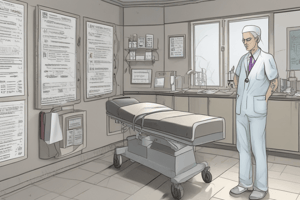Podcast
Questions and Answers
What is the primary purpose of documentation in nursing?
What is the primary purpose of documentation in nursing?
- To create promotional materials
- To serve as a legal record (correct)
- To facilitate billing procedures
- To analyze staffing needs
Which of the following best defines Information and Communication Technologies (ICT) in nursing?
Which of the following best defines Information and Communication Technologies (ICT) in nursing?
- Only refers to patient entertainment systems
- Encompasses all technology-based tools used in clinical settings (correct)
- Pertains exclusively to telemedicine practices
- Is limited to written documentation methods
Which of the following is NOT a component of nursing documentation?
Which of the following is NOT a component of nursing documentation?
- Interdisciplinary notes
- Medication administration record
- Diagnostic codes (correct)
- Progress notes
What are the key benefits of effective documentation in nursing?
What are the key benefits of effective documentation in nursing?
In which area is nursing documentation crucial for patient care?
In which area is nursing documentation crucial for patient care?
Which of the following is one of the reasons for documenting patient care?
Which of the following is one of the reasons for documenting patient care?
What type of documentation helps in tracking patient care plans and progress?
What type of documentation helps in tracking patient care plans and progress?
What is a progress note used for in nursing documentation?
What is a progress note used for in nursing documentation?
What aspect of Electronic Health Records (EHRs) is highlighted as differing from paper records?
What aspect of Electronic Health Records (EHRs) is highlighted as differing from paper records?
Which principle of documentation emphasizes the importance of accurate and timely records?
Which principle of documentation emphasizes the importance of accurate and timely records?
What do clients have the right to access according to privacy regulations?
What do clients have the right to access according to privacy regulations?
What is a significant benefit of Electronic Medical Records (EMRs)?
What is a significant benefit of Electronic Medical Records (EMRs)?
Which of the following is NOT a standard statement of CNO Documentation Practice?
Which of the following is NOT a standard statement of CNO Documentation Practice?
What is an important point to consider regarding the ownership of client records?
What is an important point to consider regarding the ownership of client records?
Which of the following accurately describes a responsibility of nurses under the principle of confidentiality?
Which of the following accurately describes a responsibility of nurses under the principle of confidentiality?
What does interprofessional communication in the context of EHRs facilitate?
What does interprofessional communication in the context of EHRs facilitate?
What does the Supreme Court of Canada state about client records and ownership?
What does the Supreme Court of Canada state about client records and ownership?
Which method is NOT mentioned as a way to document nursing care?
Which method is NOT mentioned as a way to document nursing care?
What should be considered when using artificial intelligence in healthcare?
What should be considered when using artificial intelligence in healthcare?
What is a requirement for nurses in Ontario regarding documentation?
What is a requirement for nurses in Ontario regarding documentation?
What does the acronym DAR stand for in nursing documentation methods?
What does the acronym DAR stand for in nursing documentation methods?
In the context of electronic health records, what is a potential issue highlighted?
In the context of electronic health records, what is a potential issue highlighted?
Which documentation method focuses specifically on problems or concerns?
Which documentation method focuses specifically on problems or concerns?
What is a key point regarding documentation in healthcare?
What is a key point regarding documentation in healthcare?
Flashcards
What is Documentation?
What is Documentation?
Documentation is the systematic recording of information, whether paper or electronic.
Reasons for Documentation
Reasons for Documentation
Documentation is vital for legal compliance, communication, patient safety, funding, and research.
Documentation Components
Documentation Components
Documentation includes various elements, such as admission sheets, progress notes, referrals, orders, and discharge plans.
Progress Notes
Progress Notes
Signup and view all the flashcards
Client Health Record
Client Health Record
Signup and view all the flashcards
ICT in Documentation
ICT in Documentation
Signup and view all the flashcards
Legal Obligation in Documentation
Legal Obligation in Documentation
Signup and view all the flashcards
Nursing Process & Documentation
Nursing Process & Documentation
Signup and view all the flashcards
Electronic Health Records (EHR)
Electronic Health Records (EHR)
Signup and view all the flashcards
Benefits of EHR
Benefits of EHR
Signup and view all the flashcards
EHR Considerations
EHR Considerations
Signup and view all the flashcards
Documentation Accuracy
Documentation Accuracy
Signup and view all the flashcards
Nurse Accountability
Nurse Accountability
Signup and view all the flashcards
Client Right to Access Info
Client Right to Access Info
Signup and view all the flashcards
Privacy in EHR
Privacy in EHR
Signup and view all the flashcards
Confidential Health Info
Confidential Health Info
Signup and view all the flashcards
Client's Rights to Health Records
Client's Rights to Health Records
Signup and view all the flashcards
Documentation Methods
Documentation Methods
Signup and view all the flashcards
Charting by Exception
Charting by Exception
Signup and view all the flashcards
Narrative Documentation
Narrative Documentation
Signup and view all the flashcards
Data Literacy (Healthcare)
Data Literacy (Healthcare)
Signup and view all the flashcards
AI Bias in Healthcare
AI Bias in Healthcare
Signup and view all the flashcards
Nurse Documentation Obligations
Nurse Documentation Obligations
Signup and view all the flashcards
EHR (Electronic Health Record)
EHR (Electronic Health Record)
Signup and view all the flashcards
Study Notes
Documentation Overview
- Documentation encompasses both paper and electronic record-keeping of a client's health status and care.
- Nurses are legally obligated to document accurately, timely, and comprehensively.
- Ontario nurses must abide by the College of Nurses of Ontario's documentation practice standards.
- PHIPA (Personal Health Protection Act) is a crucial provincial law that governs the collection, use, and disclosure of personal health information.
Documentation Components
- Essential components include admission sheets, progress notes/interdisciplinary notes, referrals, and consultations.
- Diagnostic, laboratory, and therapeutic orders, medication administration records (MARs), flow/graphic sheets, Kardex summaries, nursing care plans, operative procedures, discharge plans, critical incident reports, and workload measurement tools are also included.
Documentation Reasons
- Legal obligations, such as the College of Nurses of Ontario's documentation practice standards, are crucial.
- Effective communication, continuity of care, and clinical judgment are essential considerations.
- Client safety, quality improvement, funding, research, and population/clinical health insights are other critical reasons.
Documentation Principles
- Communication: Documentation should accurately, clearly, and comprehensively describe client needs, nurse interventions, and client outcomes.
- Accountability: Nurses are responsible for accurate, timely, and complete documentation of client care.
- Security: Maintaining confidentiality, adhering to information retention/destruction policies, and complying with relevant legislation are crucial.
Electronic Documentation Systems
- Electronic medical records (EMRs) and electronic health records (EHRs) are common practices.
- Benefits of EMRs/EHRs include real-time data, seamless care, interprofessional communication, analysis, and various vendor solutions.
- EHRs feature structured and unstructured data elements.
Privacy, Confidentiality, and Security
- Individuals have rights to their personal health information and access to it.
- Personal Health Protection Act (PHIPA) regulates the collection, use, and disclosure of personal health information, which is the responsibility of health information custodians (e.g., nurses).
Documentation Methods
- Documentation methods like charting by exception, narrative approaches, nursing process focused on issues/concerns/problems, data action response (DAR), assessment plan intervention evaluation (APIE), and subjective, objective, assessment, plan, intervention, evaluation (SOAPIE) are vital.
Future of Documentation
- Client participation and data literacy are important aspects of future documentation; EHRs are evolving to become more comprehensive tools.
- Healthcare professionals should be aware of potential biases within artificial intelligence (AI) systems in EMRs/EHRs and use AI as a supplementary, not a primary, clinical tool.
Studying That Suits You
Use AI to generate personalized quizzes and flashcards to suit your learning preferences.




